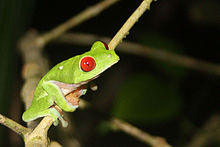Tree frog

A tree frog (or treefrog) is any species of frog that spends a major portion of its lifespan in trees, known as an arboreal state.[1] Several lineages of frogs among the Neobatrachia have given rise to treefrogs, although they are not closely related to each other.
Millions of years of convergent evolution have resulted in very similar morphology even in species that are not very closely related.[2]
Description[]

As the name implies, these frogs are typically found in trees or other high-growing vegetation. They do not normally descend to the ground, except to mate and spawn, though some build foam nests on leaves and rarely leave the trees at all as adults.
Tree Frogs are usually tiny as their weight has to be carried by the branches and twigs in their habitats. While some reach 10 cm (4 in) or more, they are typically smaller and more slender than terrestrial frogs. Treefrogs typically have well-developed discs at the finger and toe tips; the fingers and toes themselves, as well as the limbs, tend to be rather small, resulting in a superior grasping ability. The genus Chiromantis of the Rhacophoridae is most extreme in this respect: it can oppose two fingers to the other two, resulting in a vise-like grip.
Family[]
Tree Frogs are members of these families or genera:
- Hylidae, or "true" treefrogs, occur in the temperate to tropical parts of Eurasia north of the Himalayas, Australia and the Americas.
- Rhacophoridae, or shrub frogs, are the treefrogs of tropical regions around the Indian Ocean: Africa, South Asia and Southeast Asia east to Lydekker's line. A few also occur in East Asia.
- Centrolenidae, or glass frogs, are potentially closely related to hylids; these translucent frogs are native to Central and South America.
- Hyperoliidae, or reed frogs, are closely related to the burrowing Microhylidae; these small frogs are native to sub-Saharan Africa.
- Boophis is a genus of highly arboreal frogs which evolved from the toxic terrestrial Mantellidae of Madagascar.
Gallery[]

Gray tree frog, Hyla versicolor, Hylidae, eastern North America

Common tree frog, Polypedates leucomystax, Rhacophoridae, southern to eastern Asia

Powdered glass frog, Cochranella pulverata, Centrolenidae, Honduras to Ecuador

Big-eyed tree frog, Leptopelis vermiculatus, Hyperoliidae, Tanzania

White-lipped bright-eyed frog, Boophis albilabris, Mantellidae, Madagascar

Malabar tree toad, Pedostibes tuberculosus, Hyperoliidae, India
Sound of treefrogs in south Georgia, US (78 seconds)
References[]
- ^ Amphibians (2008-04-22). "Tree Frog Info". Animals.howstuffworks.com. Retrieved 2013-06-03.
- ^ Rowley, Jodi. "Frogs in the trees". The Australian Museum. Retrieved 2019-04-01.
Bibliography[]
- Richardson, C.; Lengagne, T. (2009). "Multiple signals and male spacing affect female preference at cocktail parties in treefrogs". Proceedings of the Royal Society B: Biological Sciences. 277 (1685): 1247–1252. doi:10.1098/rspb.2009.1836. PMC 2842810. PMID 20018785.
External links[]
| Look up tree frog in Wiktionary, the free dictionary. |
| Wikimedia Commons has media related to Neobatrachia. |
- Tree frogs
- Frogs
- Amphibian common names






